Visiting the 15 Most Beautiful Temples and Shrines in Japan + Etiquette and FAQs!

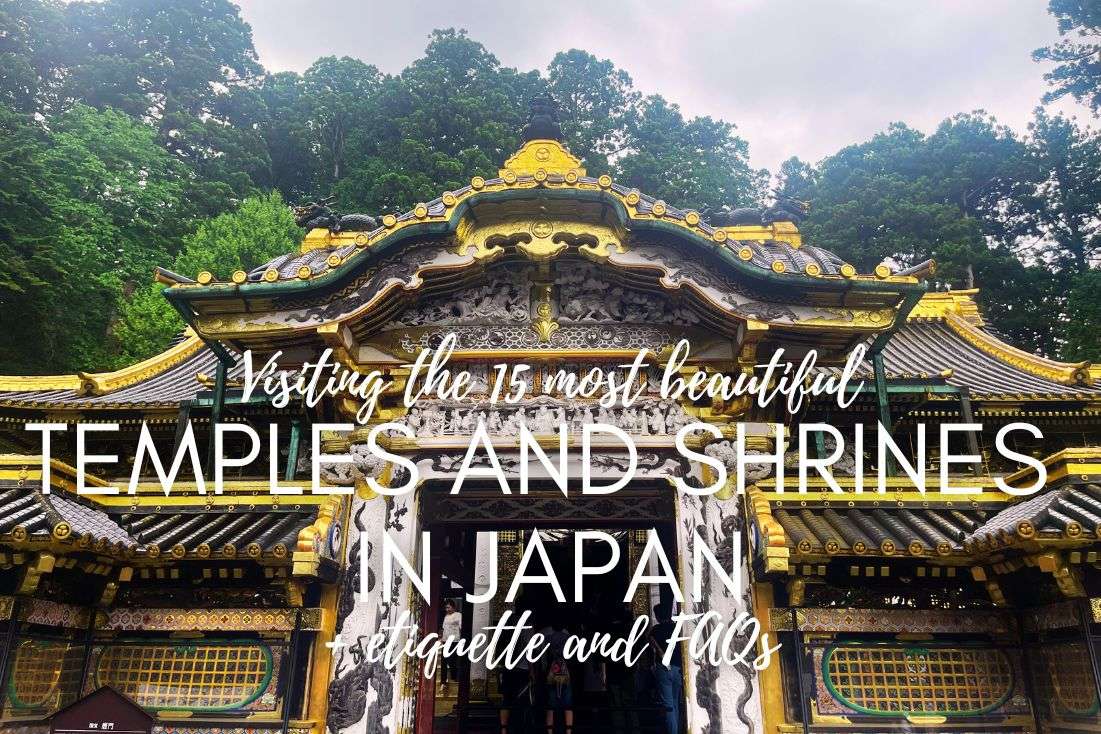
There’s always that one thing in your next destination that you’re holding out the most hope for—in Japan, it was the temples and shrines for me. I was expecting impressive sites where one step inside and I’d be blown away by the beauty and humbled by the tradition sending shivers right down to my bones… And boy was I disappointed! But there’s a simple fix: Expect nothing from the shrine and temple interiors, and everything from the exteriors. There, expectations fixed.
Japanese temples are spectacular on the outside. But, have no fear, there were fantastic exceptions too, where the inside was where the action was—you just need to know where to look, and it also helps to come educated to really grasp the meaning of these places.
So, in this article, I’ll give you my honest opinions and firsthand experiences at 15 of Japan’s most famous temples and shrines so you know what I know and you can go into your trip with adequate expectations. I’ll also add some FAQs so you know how to act at Japan’s sacred sites and can identify what the heck you’re looking at (and why you are ringing that bell).
All articles about Japan can be read here.
What’s the difference between a temple and shrine?
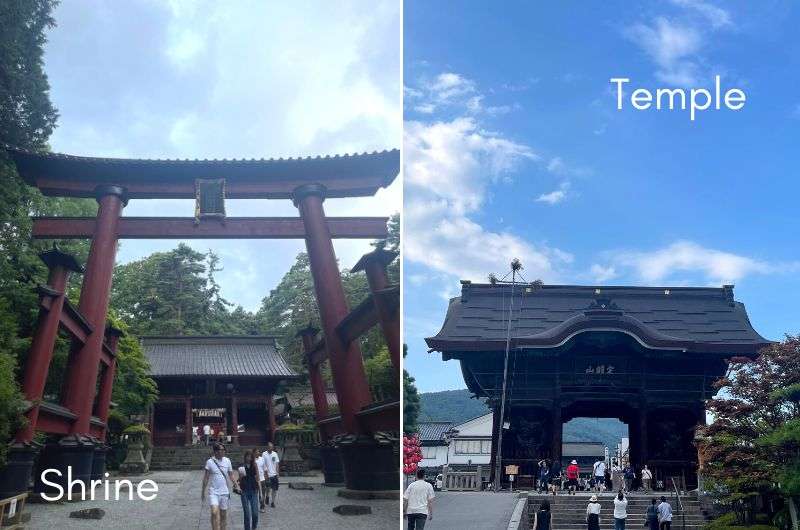
To give you a better idea of the gates
The most important difference between a Japanese shrine and temple is the religion they serve: temples are Buddhist and shrines are Shinto (Japan's indigenous religion). And whether or not they have that cool gate at the entrance.
A shrine’s entrance is marked by that famous Japanese gate you see all over Instagram—the torii. It’s meant to mark the border between the secular world and the sacred world. And sacred it is—in Shinto, there’s a divine spirit, called a kami, in everything—nature, people, even the weather! There’s supposed to be like 8 million of them, which, in Japan, amounts to infinity. Shrine grounds are usually simpler than temple grounds with less other structures.
A temple’s gate is much more massive than a shrine’s torii, looking like a building without walls, and is called a sanmon. There are also usually more buildings on the grounds than at a shrine, like the monks’ quarters and a pagoda or five. Temple procedures are less strict and elaborate than a shrine’s.
Shrine and temple etiquette and rules
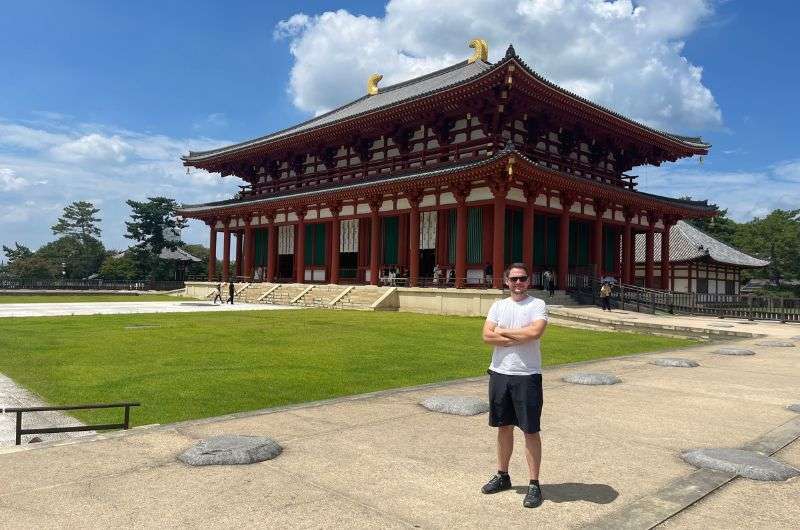
Japan is full of etiquette rules—be respectful and follow them
Japan’s big on following rules and societal expectations, and even though they won’t show any negative emotions or cause any sort of scene in order to “protect the harmony”, despite how much of a tourist dimwit you’re being, one can only guess they’re judging your bad temple etiquette on the inside and probably feeling mortified for you.
While I assume you’d always behave somewhat well at a sacred place, here are a few specific shrine and temple etiquette tips for you so you go prepared and don’t offend an entire country and both of its main religions:
- Dress conservatively. There’s no official dress code, so this one’s on you and your consideration. I don’t think I’ve ever seen a Japanese knee or shoulder at temples or shrines, so I’ll just leave you with that. But you’ll notice from our photos that we brought quite a few Czech knees into Japanese temples and didn’t feel one bit out of place.
- Take off your shoes. Not all temples and shrines require this, but it’ll be pretty obvious by the shoe rack at the front. When in doubt, look around and do what the locals do. Wear good socks (or have ‘temple socks’ in your bag to avoid lifelong shame)!
- Be calm and quiet. If you’ve been in Japan for a while, you’ll automatically start to speak quieter. Being loud and rowdy is a big no-no in Japan, so it just happens naturally.
- Look out for ‘no photography’ signs inside many shrines and temples. You’re fine taking pics outside. When in doubt, ask—don’t just stick your iPhone in a monk’s face. Not that that’s ever ok.
- It’s frowned upon to enter sacred sites when you’re sick or injured. The deities want nothing to do with your impurities.
Rules for entering a shrine in Japan
Now that you’ve put on your best pair of socks and turned down the volume, here’s how to enter a Japanese shrine:
- Walk to the side of a torii at a shrine. Unless you’re a god, you’re not supposed to walk through the middle of it, but rather a bit to the side (you can still go through the gate). You’re supposed to bow once before going through.
- Next stop: the purification pavilion. Use the ladle to get 1 scoop of water. Poor it over your left hand, right hand, and then scoop some (using your hand, not the ladle!) into your mouth and spit on the ground. Make sure none of the water that you’ve scooped up goes back into the fountain. Nobody needs to be washing their sins away with your cooties.
- At the outside alter, throw a coin into the offering box. Bonus points if it’s a 5-yen coin, because the Japanese pronunciation of “5 yen” is 'goen' which also means “good luck” or “good relationship”. Wishful thinking of sorts.
- You can ring the bell to announce yourself to the kami. See, it’s rude to visit unannounced even in sacred lands.
- If you’re really looking to get extra brownie points with the kami, do the traditional “two bows, two claps, one bow” and then head inside.
How to enter a temple in Japan
There seem to be less hoops to jump through if you’re visiting the Buddhist temples in Japan. Basically, if you aren’t half naked and act in a reserved manner, Buddha will be happy with you.
- Go through the sanmon gate. No special rule there.
- If there’s a purification station, stop by and wash your hands and mouth just like you would at a shrine. If not, go in dirty.
- Take off your shoes and leave them at the entrance. We saw people that were wearing sandals put on socks from their bag, but I don’t think going in barefoot would be terrible either.
- Throw some coins into the offering box. No preference for 5 yen coins here.
- Buy and burn incense (voluntary). It’s important to put out the flame on the incense by fanning it with your hand and not blowing it out with your mouth. If there’s a part of your body that’s causing you trouble, you can direct the incense smoke to it and hope that helps. If you smoke your head, you’ll be thinking clearly in no time!
My top 15 list of the most beautiful temples and shrines in Japan
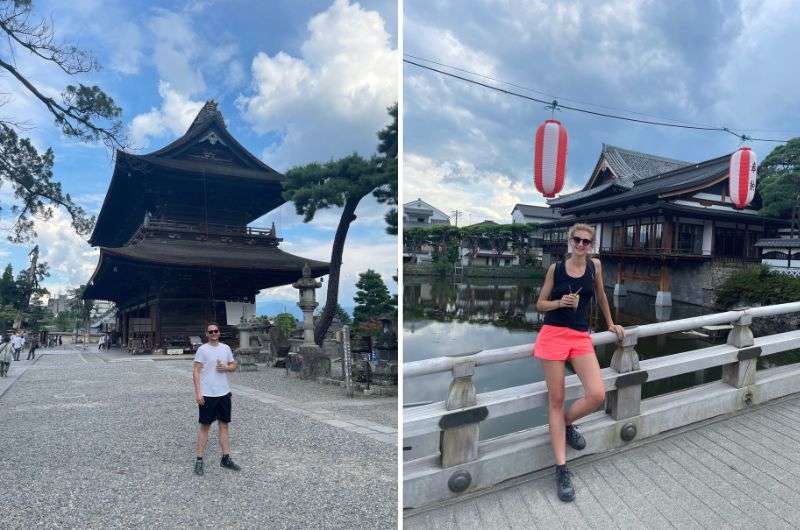
We've been to a lot of temples in Japan, and we're happy to tell you which ones are the best. Here at Zenkō-ji
Alright, now that you know how to enter, let’s talk about where to enter. Here are the most famous Buddhist temples and Shinto holy sites in Japan that I think are worth a visit, in order from my most favorite to least favorite (but still worth going). With a total of over 80,000 shrines and as many temples in the country, the 15 most beautiful ones on my list are obviously going to be worthy of your time—they beat out a lot of competition!
You’ll notice that Kyoto is temple central. With 2000 temples and shrines, choosing which ones to visit is quite the task… or was. Before you found my article.
Note on tickets: At many of these temples, you only pay the entrance fee when entering the main building or a specific area. So, don’t be alarmed if you’re going through the gates and can’t find the ticket desk. You’ll know when it’s time to pay.
1. Togakushi Shrines (Nagano)
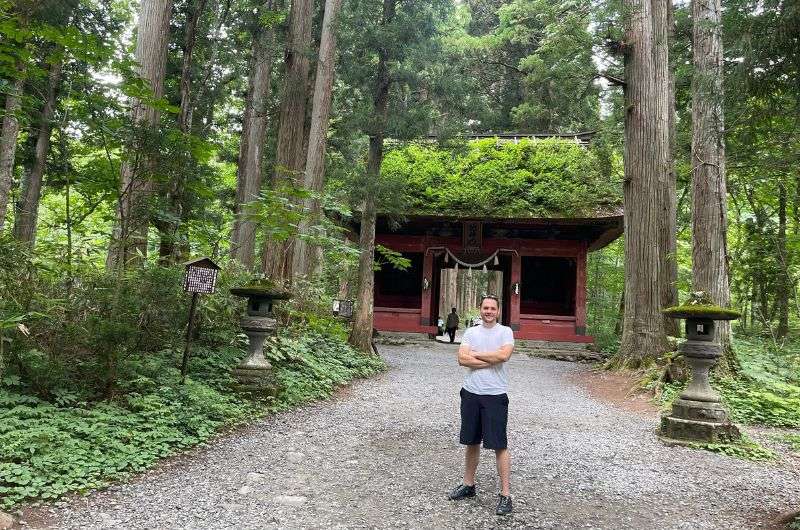
Me on my pilgrimage to the Togakushi shrines
Let’s start with a shrine combo located a 30-minute drive northeast of Nagano. It’s a total of 5 shrines (with 3 main ones) on the Togakushi mountain, and you can visit them all by hiking a beautiful 5 km (3 mi) trail (with lots of stairs). My heart jumped with joy! I’d go as far as call it one of the most beautiful places in Japan. It’s not just shrines, but the hike, a lake, a ninja museum, and the wonderful nature that makes Togakushi a must-visit.
Further reading: Nagano itinerary | Nagano best places to see (I loved Nagano!)
To add to my glee, there’s an abundance of interesting restaurants in the area. Hey, a traveler’s gotta eat, especially if they’re a foodie like me (get the juicy details in my Japanese Food Guide)!
This place will keep anybody happy for a full day.
The shrines at Togakushi are on 3 levels of the mountain trail, and have to do with a story in Japanese mythology.
Mythology explanation: The Sun Goddess Amaterasu was ashamed of her brother’s behavior and hid in a cave (sheesh, even the gods can’t escape Japanese shame culture!). Darkness ensued, so other deities lured her out again with a dance performance. Once she was out, one of the deities grabbed the cave door and threw it away so the Sun Goddess couldn’t shut herself in the cave again.
Each shrine is dedicated to a deity from the Sun Goddess story, and Togakushi Mountain is the stone door from the Goddess’ cave. Togakushi literally means ‘hiding door’.
Hiking the Togakushi 5 shrine trail
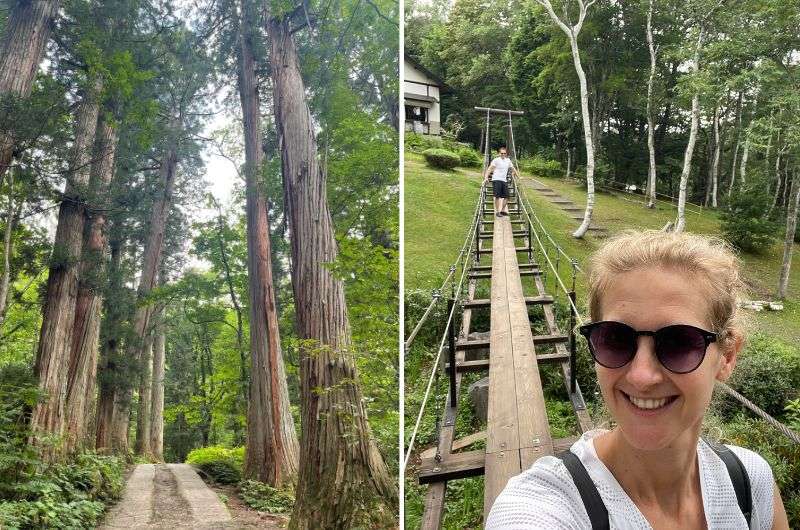
On our way to Ninja Museum through beautiful Togakushi trail
It’s about 5 km (3 mi) of paths and many staircases between each of the 3 levels where the shrines are: Hokosha and Hinomikosha (lower shrines), Chusha (middle shrine), Kuzuryusha and Okusha (upper shrines). Hinomikosha and Kuzuryusha are smaller shrines, the others are the main ones.
We used the parking areas on the approach to the upper shrine, Okusha. Straight out of the car you’re walking about 40 minutes through a gorgeous forest of giant cedar trees until you get to Zuishinmon gate. Not to mention the great weather
We headed into the Ninja Museum and Folk Museum, which was quite interesting despite the limited English signage. You learn about rural life, there’s a cool silk exhibit, and one part looked like an uncomfortable shoe collection. The most fun that my girlfriend couldn’t stop talking about was getting through all the tricks and traps in the Ninja Fun House. She kept reliving our quest to get through the roughly 30-minute-long endeavor for the entire rest of our Japan trip! Once you manage to get out, the views to the surrounding mountains are gorgeous! There’s also an area where you can throw shurikens aka ninja stars.
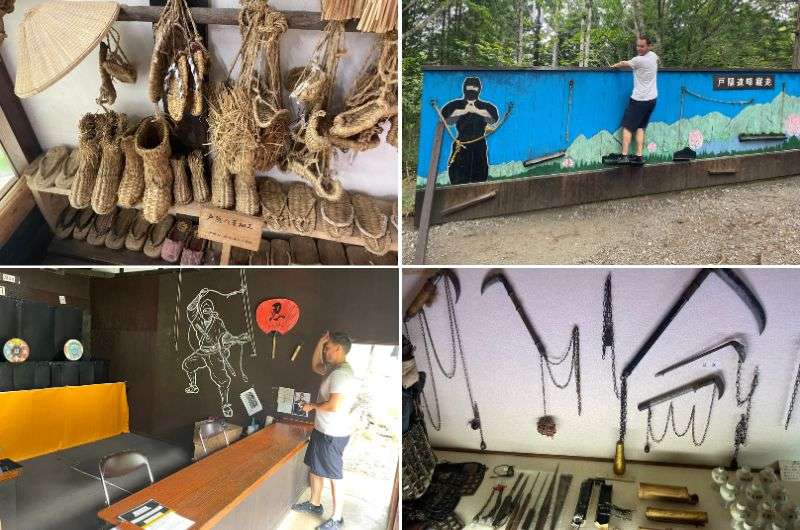
I’ve had fun in the Ninja Museum!
A side trail from the upper shrine (that then re-connects to roughly the middle of the main trail) leads you to Kagamiike Lake. The scenery at the lake very roughly reminded me of views in Thailand and Vietnam. You can easily spend 2 hours just on this hike, though we spent even longer—the internet in hyperconnected Japan hasn’t quite reached these further stretches of nature, and we got lost a few times. No stress though, the forest is very nice! It doesn’t help that all the signs are solely in Japanese—this is your friendly reminder to download Google Translate before heading out.
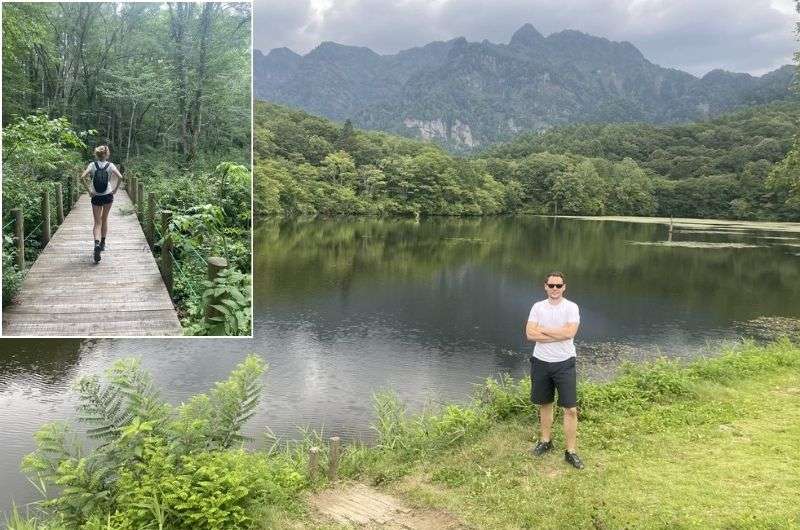
Kagamiike Lake and the trail to it was wonderful, though we didn’t quite get clear skies and the “mirror lake” effect
- You’ll want to allow around 3 hours for the 5 shrines hike. Add 1.5 hours more for the Ninja and Folk Museums and 2 hours for the lake.
- Museum tickets: JPY 650. There’s no entrance fee for the trail.
2. Tōdai-ji (Nara)
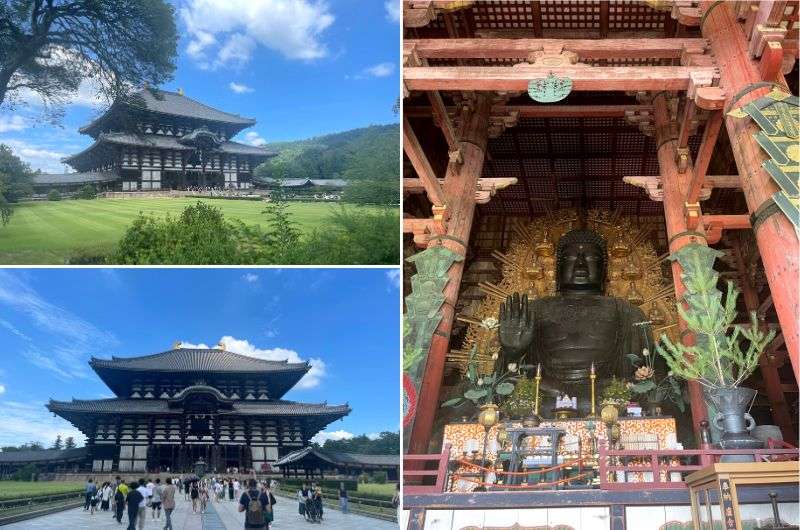
Great Eastern Temple
Nara’s Tōdai-ji, or “Great Eastern Temple”, is one of the most historically important temples in all of Japan. It was originally built in 752 when Nara was the imperial capital, and every Japanese citizen paid for it by being taxed (sometimes to the extreme).
Further reading: Nara itinerary—The perfect day trip from Kyoto
The most famous building on Tōdai-ji’s very large grounds is the very large, wooden temple called Daibutsuden (Big Buddha Hall). Until the end of the 20th century, Daibutsuden was the largest wooden building in the world, so you can imagine that it’s no dainty shack. It had to be rebuilt, saved, and reconstructed several times due to wars. Nowadays, it’s little more than half the size of the original, and that’s mainly because the ginormous amount of cedar wood needed to build it. Despite clearing entire forests, traveling hundreds of kilometers and building over 100 river dams, there just wasn’t enough wood they could get for this huge building. Can you imagine that?!
Honestly, it blew me away by just how massive it is. It feels way more colossal than Europe’s cathedrals. Daibutsuden is roughly 50 m (180 ft) long, wide, and tall.
There’s also the spectacular entrance gate to Tōdai-ji where you’ll meet many very cute deer wandering around from Nara Park. The guardian statues at the temple are anything but cute, they’re seriously monsters and you wouldn’t want to anger them.
You can get a free English guide on the spot (human, not paper). The Big Buddha Hall houses a huge sitting Buddha—the palm of his hand is the size of a human. And his nostrils are apparently the way to nirvana. You can try to make the journey yourself by attempting to squeeze yourself (or maybe your very small child) through the hole on the pilar close to the Buddha which is the same size as his nostril. Good luck and don’t get stuck.
I was surprised by the lack of monkeys at Tōdai-ji… maybe the deer ate them all?
- Allow at least 1 hour for your visit
- Temple tickets: JPY 600
3. Kinkakuji (Kyoto)
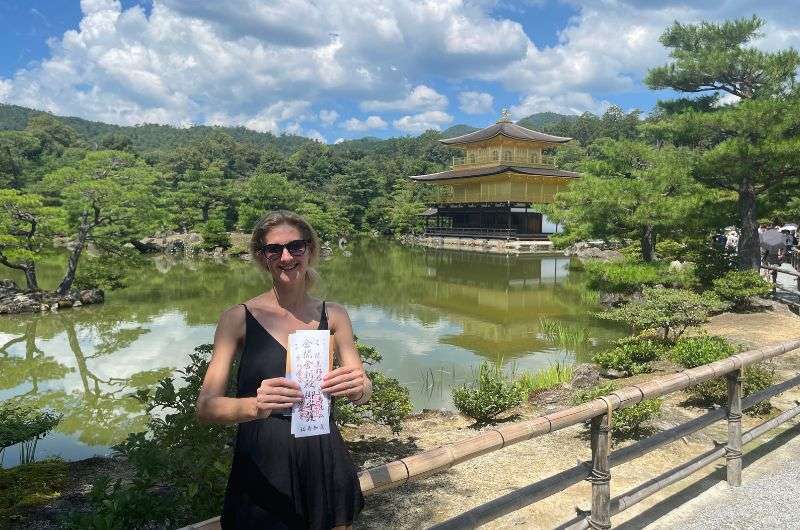
Everything about this picture is beautiful...the temple, lake scenery, tickets, and my girlfriend
And rounding off the top 3 temples in Japan is Kinkakuji (Golden Pavilion)—a former shogun’s retirement villa who’s top two floors are completely covered in gold leaf, making it quite a striking beauty on a lake. They have the details down at this place—I even kept our tickets for the first time ever! They are very nice.
I’d rank the Kinkakuji as one of the top 3 buildings in Japan, though it’s quite small, but the gold and the lake scenery makes it truly beautiful.
Hotel tip: KAYA Kyoto Nijo Castle (I can’t get behind the classic Asian breakfasts, but this hotel has such epic rooms that it totally won me over.)
Kinkakuji has 3 floors, each in a different architectural style: the 1st floor is built in the Shinden style of palaces during the Heian period, the 2nd floor is gives samurai home vibes in Bukke style, and the 3rd floor is that of Chinese Zen style, with gold inside and out and has a golden Pheonix on top. You’ll need to be content with getting a good view of the pavilion from across the lake, because entrance is forbidden.
Being such a small place means you only need an hour or so to see it at a leisurely pace. There was a ton of people there when we visited, to the point where every single tourist from Europe and the US annoyed the heck out of me. Can you not give me 3 seconds to take a photo without butting into the frame?? The Japanese locals were respectful as always and had no trouble at all letting everyone get their pics in peace, but sheesh, those westerners got an earful from me! The good thing is that at least everyone has to keep moving in one direction.
You then go on through the gardens and a teahouse where you can rest a bit under the red maple trees.
Also! It’s the first place I visited in Japan where garbage cans are readily available! It felt… luxurious!
Kinkakuji is located on the outskirts of Kyoto, about a 20-minute drive from the city center. Not far away are two other temples (for you temple-obsessed travelers, but not for me) and Arashiyama Bamboo Groove. Further reading: The best unique things to see only in Kyoto
- Allow 1 hour for your visit
- Tickets: JPY 500
4. Zenkō-ji (Nagano)
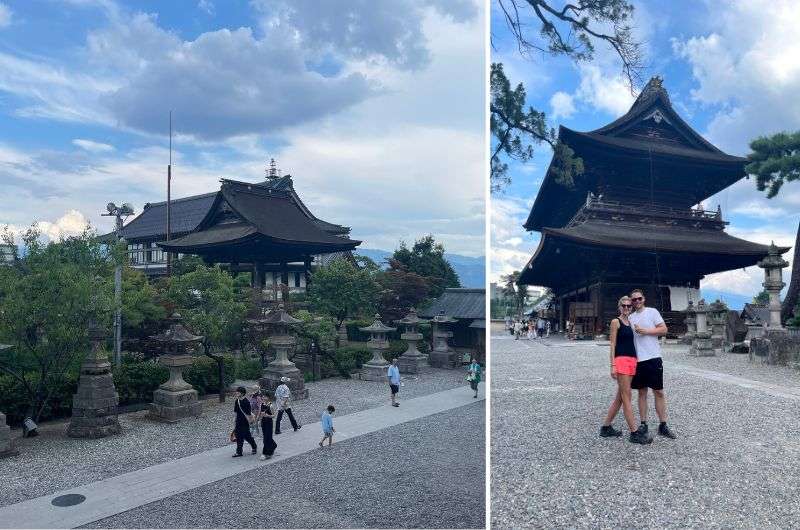
Zenkō-ji temple
Zenko-ji is the reason Nagano even exists. Some Japanese cities were built around harbors, some around castles, and other around temples. Nagano evolved around Zenko-ji. It was founded in 642 and houses one important, top-secret item: what may be the first Buddhist statue ever to be brought into Japan. The statue is so special that nobody’s ever seen it… I’m not even kidding. The thing has been hidden away since they found it and built a temple for it due to the temple’s secrecy commandment. Somehow though, there is a replica of it that gets shown every 6 years to crowds of pilgrims and tourists alike. Your next chance is in 2028.
As with most temples, there are many buildings on the grounds, including the Zenko-ji History Museum. The Main Hall at Zenko-ji has one peculiar addition to the many, many Buddha statues inside it—an underground passage where people walk in complete darkness trying to touch the “key to paradise” that hangs on one of the walls. If any of my readers manage to touch it, let me know if the promise of salvation works out for you so I know if I need to go back.
There are two gates: Nioman Gate in the south at the beginning of the approach to Zenko-ji, and Sanmon Gate right near the Main Hall. You can climb Sanmon and get nice views of the temple grounds and the long path towards it.
- Allow 1–2 hours for your visit (depending if you go into the museum or not)
- Tickets: JPY 500 + JPY 600 for Main Hall
5. Kyomizu-dera (Kyoto)
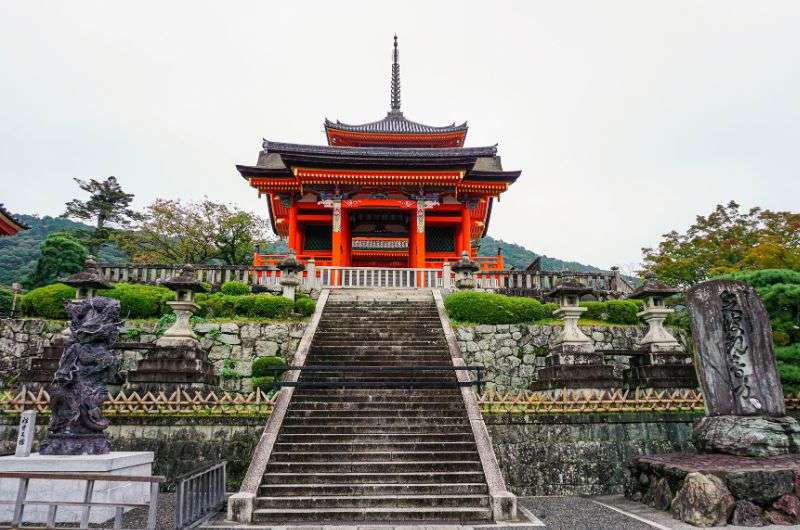
Kyomizu-dera—the place dedicated to the magic of love!
If you need help in any stage of love, Kyomizu-dera is the temple for you. But more on that later. It is dedicated to Buddhist and Shinto deities, so if there’s any place where the magic of love could work out, it’s here! It’s also one of the places that I have almost no recollection of the interiors; the exteriors, scenery, and all the fun love stuff are the main attractions for sure. In hindsight, this was one of my favorite temples in Japan, but since I visited it in the beginning of our trip, I didn’t appreciate it quite enough.
This place was PACKED in the summer (think B.O. and sweaty body parts very close to you), so come here prepared to share the (admittedly large) space.
Kyomizu-dera is probably most known for the large wooden terrace of the main hall that gives you views over the nice, forested area and Kytoto down in the not-so-far distance. You’re literally just a 10-minute walk from the city’s busy lanes lined with souvenir shops (there’ parking there, too). Though, Sannenzaka Path is pretty scenic and so quintessentially Japanese.
Further reading: The best thing to see only in Kyoto
Otowa Waterfall is the reason the temple is built here—hence the name "Pure Water Temple"—, and you, too, can catch some of the water from the falls and drink to one of three wishes that you hope will come true: a long life, success in education, or finding love. Just line up (we waited only about 10 minutes) and do what the locals do if you want to participate. You’ll notice everyone drinking with from the same ladles, but they go in a little UV sanitizing cubby after each use, so just try to take the one that has been sitting there the longest. Also, you’re not supposed to wish for all 3, because being that greedy is frowned upon. The waterfall is right by the main hall.
I really liked the two gates at Kyomizu-dera, as they’re both bright red and stand very tall. The main gate, Niomon, is the first spot where you’ll be above the surrounding buildings, so it’s bound to be the spot for photos, meaning there’s always a human traffic jam there. The west gate, Saimon, leads to paradise, so don’t walk through it before you’ve seen the rest of the temple grounds! Just kidding.
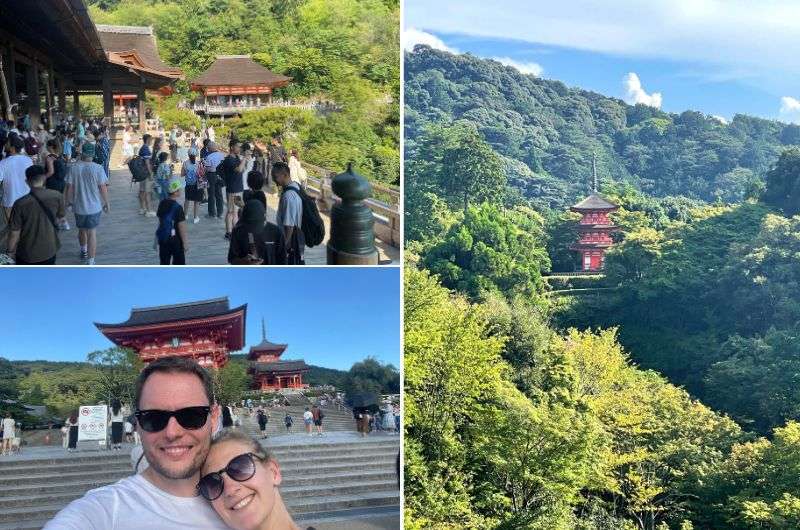
Kyomizu-dera from different angles
When you’re standing on the main hall’s terrace, don’t forget to look around and realize that the whole building is built without nails. That’s some impressive architecture right there.
Behind the main hall is a smaller shrine dedicated to love and matchmaking, and in front of it, two “love stones”. If you can walk between them with your eyes closed, you’ll be meeting your love very soon. Not sure what happens if you’re already there with a love, but hey, the more the merrier!
Closeby is Zuigudo temple where you can wander around in complete darkness reminiscing about the time you spent in your mother’s womb. Strange, I don’t remember bumping into so many people in there…
If you’re in further stages of your love story and you’ve crossed off the womb experience from your list and are ok with it, wander a bit further to the red Koyasunoto Pagoda—it’s dedicated to childbirth (you’ll also get the some different views from these parts).
- Allow 1 hour for your visit
- Tickets: JPY 400 for the main hall
6. Fushimi Inari Shrine (Kyoto)
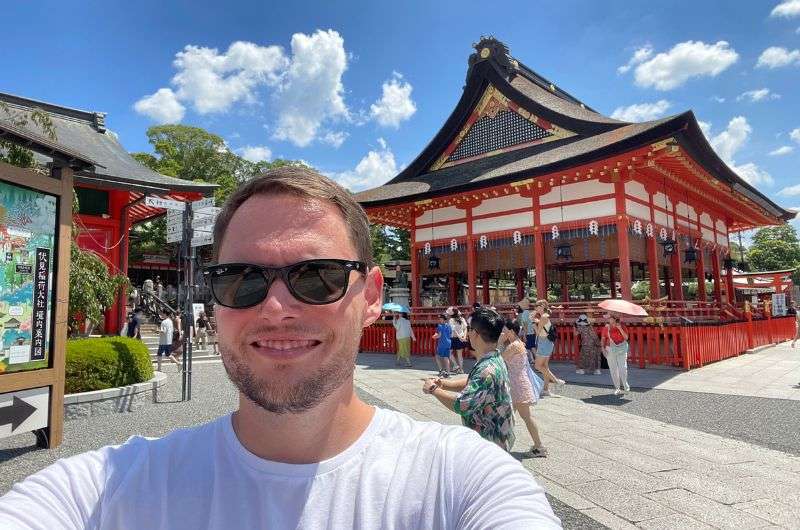
Me, exploring the Fushimi Inari Shrine
An absolute must-see Shinto holy site and possibly the most photographed shrine in Japan is the Fushimi Inari Taisha—the one with a thousand red torii gates (not that anyone’s ever seen a photo of the actual shrine). To answer the top question: It worth going? Yes. You have to, you simply can’t come to Kyoto and not visit Fushimi Inari. Is it all that you’ve dreamed it to be? Probably not, if you weigh the experience against the massive hype it gets.
Why are there so many torii gates at Fushimi Inari? The shrine is dedicated to rice and commerce, and each of the red torii has been donated by a Japanese business. This way, they’re expressing gratitude to the business gods (and probably hoping to stay on the guy’s good side in the future, too). Any why rice? Duh, this is Japan… and Fushimi Inari is the most important shrine in Japan dedicated to Inari, the rice goddess.
This shrine, or, who are we kidding, the torii gates, attracts thousands of people every day, which is part of the reason that it just isn’t that magical as you think it will be. But I get it, I added to the body count too, after all. The good thing is that it’s open 24/7, so if you are serious about beating the crowds, you can find an hour of the day where you won’t be there with busloads of other tourists. Just remember to look out for boars and monkeys if you’re visiting in the lonelier hours.
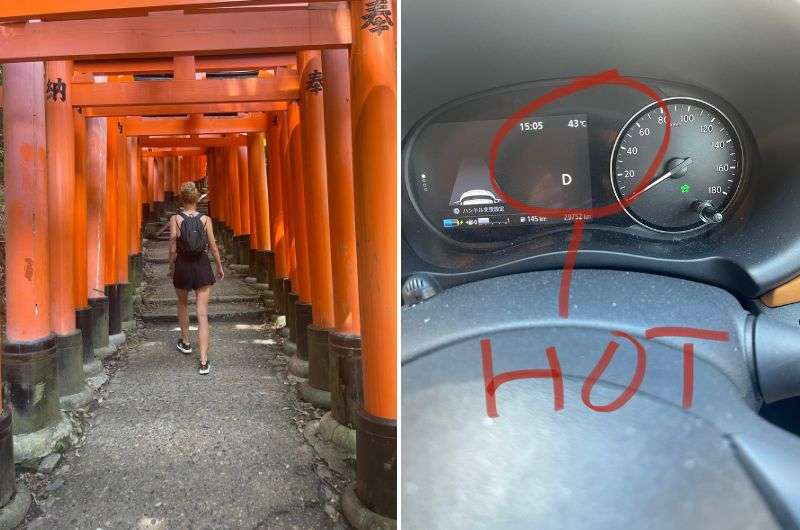
Walks In Fushimi Inari Shrine during hot weather—thank goodness for a bit of shade under the torii gates
Another thing to realize is that the further up on the trail you go, the less people there will be, because, well, it’s about 4 km (2.4 mi) or 2 hours or walking under torii gates at the base of a mountain. Not everyone is up for that, especially when you realize that the main shrine grounds are before all of the torii madness. There are side trails along the whole thing, with smaller shrines in the forrest, too. Lots of people just give up or get bored after the first 30 minutes when they reach the Yotsutsuji shrine area where there is a viewpoint and some cafes. After that, it’s just you, me, and the other real tough guys walking the rest of the trail! Bliss.
One thing I liked is that many people walk the torii path dressed in kimonos, it adds some extra Japanese flare. Another nice bonus about passing under a thousand gates is the shade they provide, though they are spaced out more the further up you go. On a hot day, a little shade goes a long way!
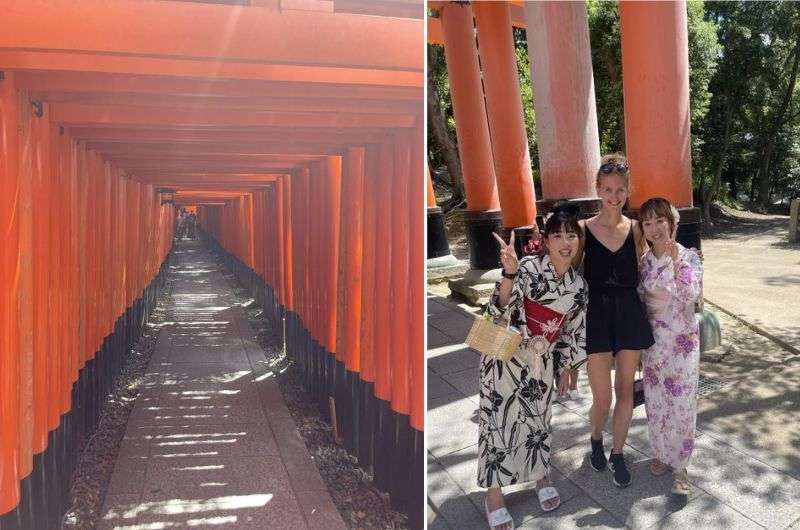
These lovely ladies wearing kimonos
I think Fushimi Inari Shrine is unmissable, but don’t expect to get a pic with just you and the gates if you get there after 8 am.
- Around 2–3 hours for the full hike, less if you just stick your head in and go
- Tickets: free entry
7. Sanjusangendo aka Rengeo-in (Kyoto)
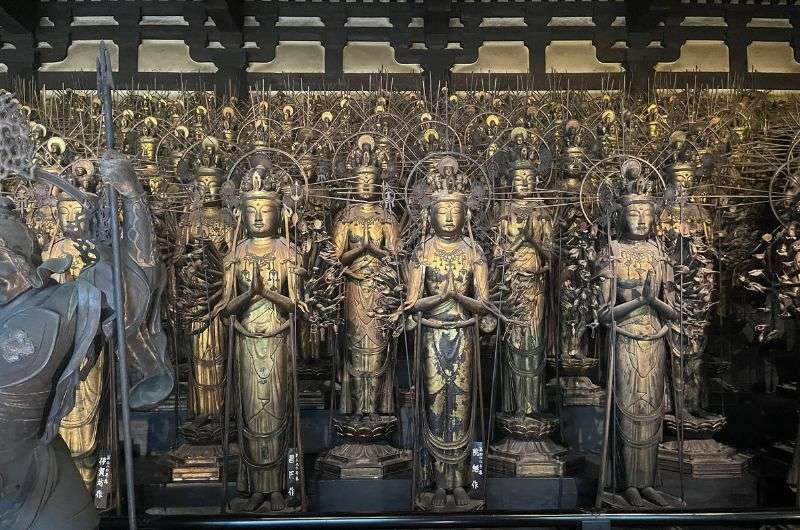
The 1001 statues representing Kannon
There’s a lot going on at Sanjusangendo. First, you’ll notice that the main hall is extra-long—the longest wooden building in Japan at 120 m (394 ft). Even the name commemorates this: Sanjusangendo means “temple of 33 bays” and references the 33 intervals between the building’s support columns. I find it funny that it’s not named something like “the temple of the impressive statues” or “the temple of the really important goddess”, but instead it’s “look at the cool long building we built”.
And then, once inside, impressed by the statues you’ll be! I was. There’s 1001 of them and they’re as tall as a real human and each one is slightly different, so they look like they could start walking around at any given moment, taking over the world. It’s all one “person”, the goddess Kannon. I was taken aback by how grand this statue display felt. It was like I’m intruding on this lady’s personal space (she obviously needs a lot of it).
Who is Thousand Armed Kannon, the main deity of Sanjusangendo? Kannon is the goddess of compassion and mercy. With her 11 heads, she can see the suffering of mankind, and her 1000 hands allow her to multitask and help everyone out. Anyone with a keen eye will quickly figure out that there’s no way she has 1000 arms. It’s not all a lie. She has 42 arms, out of which the regular 2 don’t count (those are her personal arms for things like brushing her teeth and holding her coffee cup), and in Buddhism, there are 25 planes of existence. A little bit of simple math and you’ve got 1000!
Besides Kannon’s 1001 instances you’ll also see her 28 protector statues, and the whole thing is just incredible. The statues are made of cypress and completely covered in gold leaf. Sanjusangendo is one of the few Japanese temples where the interior blew me away.
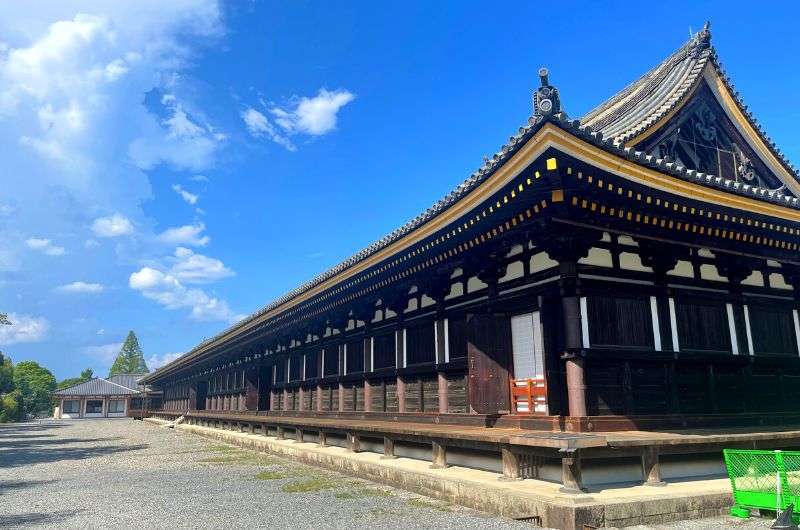
This is how majestic the loooong Sanjusangendo temple looks from the outside
There’s also a nice garden and 112 m (367 ft) of Shintoist wishes where my superstitious girlfriend picked up a very VERY large amount of wishes. For me, the collection of bows and other weapons was way more interesting that some scribbles on papers.
Fun samurai fact: Sanjusangendo was built by a samurai for a Japanese emperor (on the emperor’s own land), which seems like a nice thing to do until you learn that for doing so, the samurai got the title of “Chancellor of the Realm”. He was the first samurai to get such a lofty title, and I’m pretty sure he wasn’t surprised by this and actually built the thing for this sole reason (he was a politician). To me, the title sounds like “Guardian of the Galaxy”, so I’m kind of impressed. The emperor’s mausoleum is on the grounds of the temple.
- You need 30 minutes for the visit
- Tickets: JPY 600
8. Tsurugaoka Hachimangu (Kamakura, south of Tokyo)
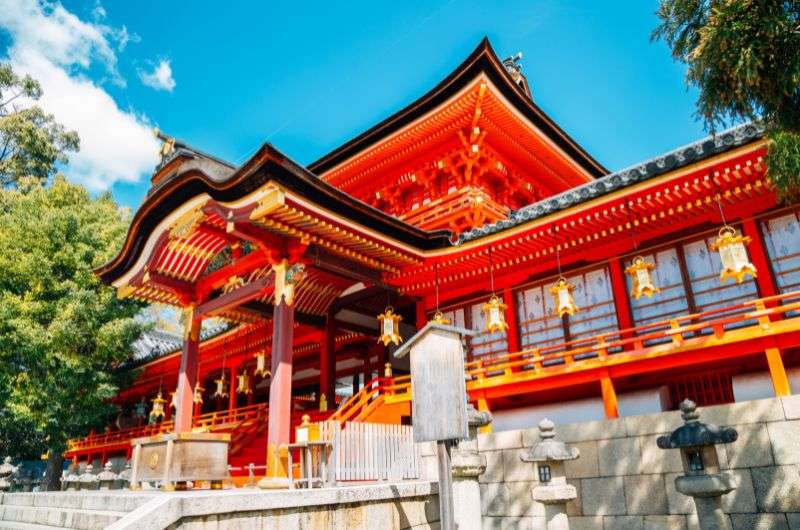
Tsurugaoka Hachimangu shrine
Tsurugaoka Hachimangu is dedicated to the samurai god, Hachiman, and you can tell it’s the most important shrine in Kamakura just based on the long, wide approach that slices through the city like a samurai’s sword. It’s fun seeing the torii gates where you’re passing through to sacred land, but at the same time you’re surrounded by very much everything unsacred: gas stations, restaurants, busy intersections, beauty salons. Then, once you reach the grounds, it’s like BAM! Tranquility.
The shrine complex is very busy but very large, so it’s crowded but still manages to feel peaceful. That’s just the norm in Japan, since the Japanese are so calm and quiet, even a thousand of them are easier to handle than a single stag party from the UK. If it does get a little too much, there are men holding a rope under the staircase, raising it when crowds need to be stopped and lowering it to let more people in, sort of like those traffic lights at tunnels in big cities.
You need to go up a wide stairway to reach the main hall, so it’s the perfect place to look back and get some views of the city. Too bad the little bridge at the grounds’ entrance seems to be permanently closed, but at least you can take a picture of it without a thousand tourists on it. The main hall houses a small museum with swords and masks and other interesting things that a guy like me appreciates.
What I liked the most at Tsurugaoka Hachimangu, maybe besides those swords, were the perfectly upkept grounds with ponds and islands and bridges and fat kois that you can feed. In the spring and winter there’s even a peony garden, and in April and September, you can see horeseback archery on the main approach. Pretty cool stuff, and nice for a wander.
As a bonus, because everyone loves toriis, there are several spots with short torii tunnels. Like a miniature version of Fushimi Inari. Take a wander around the gardens and take a peek at the other smaller shrines and buildings. There’s not a whole lot to do, but a nice place nonetheless.
- You need a maximum of 1 hour for the visit
- Tickets: JPY 200 for the museum, otherwise free
9. Sanbutsuji and Nageiredo shrine (far from everything)
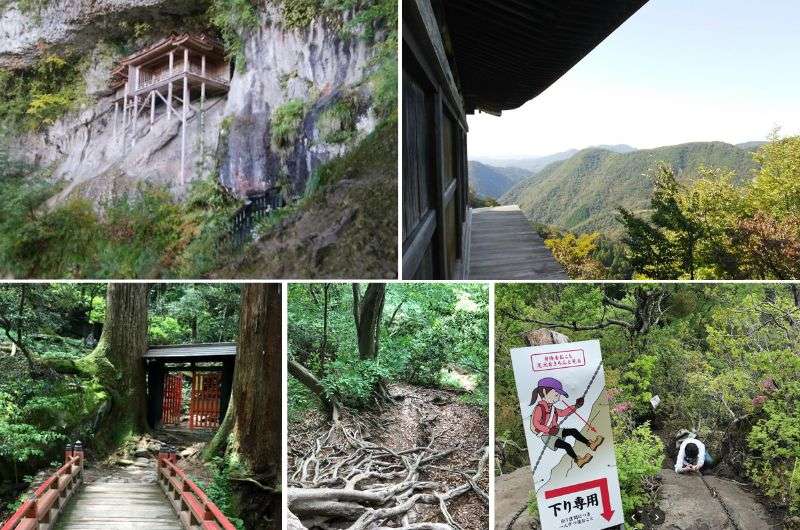
Nageiredo at the top left, Monjudo top right, parts of the path on the bottom
Sanbatsuji is one place I haven’t been because you really have to go out of your way to see it, and it just wasn’t in the cards this time around. But it needs to be on any “top temples in Japan” list, because, well, look at it! Itis old, hard to reach, unbelievably built onto the mountain, and you can’t see it alone... plus, you’ll leave spiritually cleansed! It may not be the most beautiful shrine, but it definitely has the most adventurous approach! Here’s what I know about it:
The main highlight is the tiny shrine that’s built onto the side of a mountain—called Nageiredo—, which you can only see if you go through with the harrowing hike. How harrowing? Well, the monks take it because it promises spiritual cleaning, so you can imagine it’s not easy. Think steep, slippery non-paths, holding on to huge tree roots for dear life, chains and ropes that are actually necessary to clear the slopes, and so on. Then again, they do it in funny-looking sandals that are sold on the spot for those who come in inappropriate footwear, so don’t be deterred if you’re reasonably fit.
Do be deterred if you’re traveling alone, because single travelers aren’t let onto the trail. This is for safety reasons, and they are very strict about this rule. You apparently also aren’t able to buddy-up with a stranger, or at least don’t let on that you are strangers when you do. Remember you are at a shrine, so you’ll also need to be wearing appropriate clothing, plus they’re known to turn people back if they aren’t wearing hiking shoes or willing to buy their funny sandals. The not so monk-y thing is that they ask you to pay the entrance fee and only then do you reach the checkpoint where are the rules are enforced.
Besides Nageiredo, there’s also Monjudo, another “floating” shrine about 30 minutes into the hike. This one is larger and most importantly, has a patio around it that you can go on, taking in the amazing views into the mountains. Keeping with the “adventure” theme, there are no railings, so try not to fall into the beautiful nothingness.
- Allow 2 hours for the hike up and down, more for taking it all in
- Tickets: JPY 1200 is for the hike up to Nageiredo, JPY 400 for the main hall
10. Seiganto-ji (Wakayama Prefecture, south of Nara)
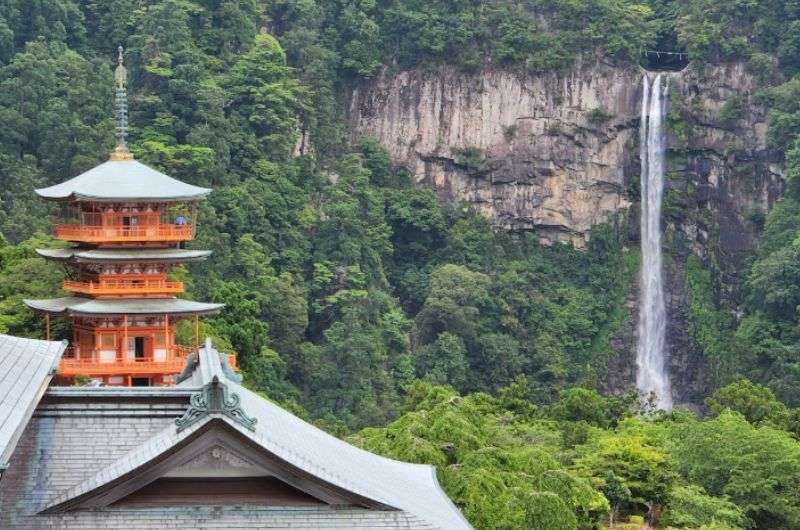
Seiganto-Ji and Nachi Waterfall
Seigantoji, a charming temple in the Wakayama Prefecture, is part of the sacred Kumano Sanzan complex, and if old walls could talk, these would have tales for days. It's a Buddhist temple, but what's cool is its BFF status with the neighboring Shinto shrine, Kumano Nachi Taisha. Talk about religious harmony!
The temple's claim to fame? Its stunning pagoda perfectly framed by the Nachi Waterfall—Japan's tallest single-drop waterfall. The view seriously is a real-life painting.
If you're up for a mix of history and leg workout, Seigantoji Temple is your go-to! Just remember that getting that waterfall into the frame is basically mandatory. The temple complex is srawling with several buildings, but the most famous is the iconic three-storied red pagoda. You could start at Kumano Nachi-taisha, continue to Seiganto-ji, visit the pagoda, and wrap up at Nachi waterfall for a full experience.
Parking tip: Parking's a breeze at most souvenir shops near the base, but then you’ll need to get your legs ready for a little stair-master rendition. For those not keen on 15 minutes of steep steps, you can pay the steep JPY 800 fee to drive to the neighboring Kumano Nachi Taisha Shrine and park there (watch out for the local deer!). On a scorching summer day, the convenience and heatstroke you save could be worth it.
- Visiting time: Give it 1–2 hours, but it really depends on how many of the 33 shrines and temples in the whole area you’ll be visiting
- Tickets: Free, but up to JPY 800 for parking
11. Senso-ji (Tokyo)
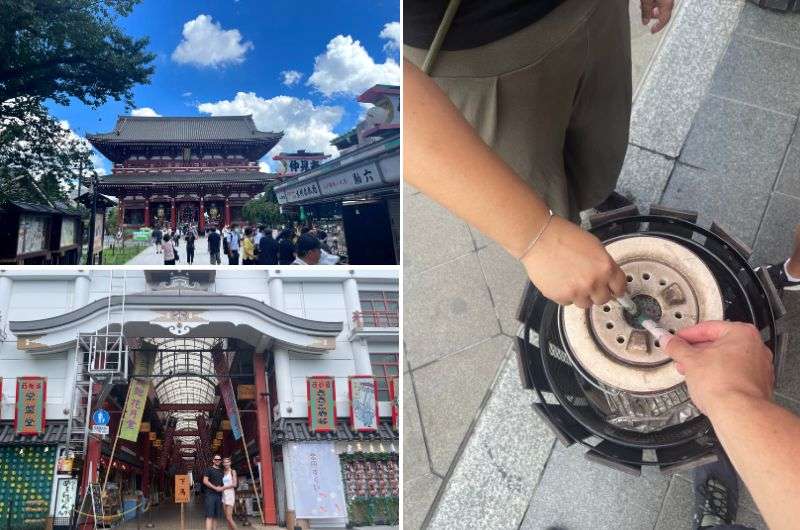
Unfortunately, I only have photos from the day, because at night I was too stunned to take pictures
Ah, Sensō-ji! This famous temple in Tokyo is like stepping into a carefully landscaped oasis. Sure, there's a fee to get all up close and personal inside the temple, but the real magic happens outside, especially at night. Strolling through Nakamise-dori Street when the sun goes down is an experience in itself.
Hotel tip: Nohga Hotel Akihabara (A little overpriced, but ultimately a great choice based on location and the great restaurant... but no heated toilet seats? What’s that about?)
The temple vibes at night are something else—it's tranquil and feels more, you know, temple-y. Morning's cool too, but brace yourself for tour group stampedes, even if you hit it up at 9 am. It's always buzzing with people, day or night. It’s also open 24/7, so you can choose the hour of your visit based on how many people you want to meet.
You'll see folks in kimonos, taking slow, elegant strolls. Not my jam, but hey, if that's your thing, just remember it'll double your exploration time. I can’t see a reason to walk around slowly pretending to be Japanese, but then again there are a lot of things people do on their trips that I don’t get.
Tip: If you happen to be in Japan in May, you may be able to witness the annual festival of the Asakusa Shrine, which is right next to the main hall.
- Allow 1 hour for your visit
- Tickets: free with a small fee for the main hall
12. Kitaguchi Hongu Fuji Sengen Shrine (Mt. Fuji)
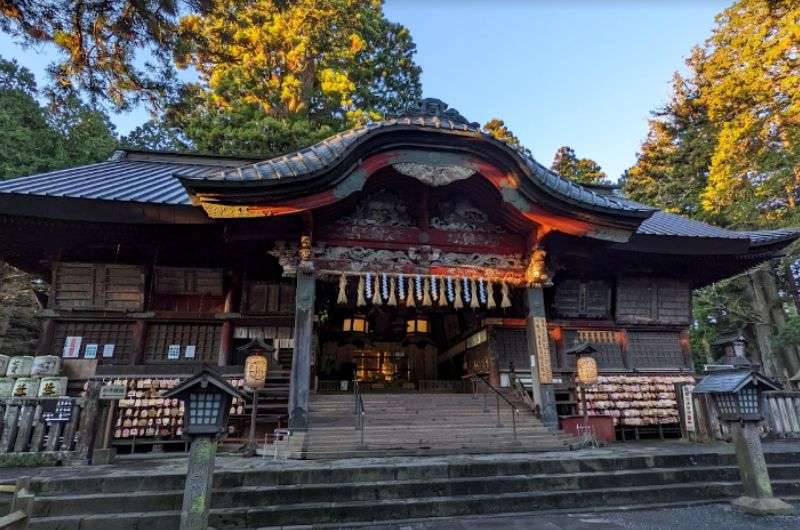
Fujiyoshida Sengen Shrine on the north of Mount Fuji
Kitaguchi Hongu Fuji Sengen Shrine (now also called Fujiyoshida Sengen Shrine) is tucked away at the northern base of Mount Fuji, and it's the kind of spot that's perfect for folks like me who love a bit of tranquility mixed with a heavy dose of history. The shrine has been the go-to start point for pilgrims heading up Mount Fuji for ages. It's not just about the shrine itself; the surrounding forest gives it this mystical, almost other-worldly vibe.
My take? If you're in Hakone and looking for a peaceful spot to reflect, away from the typical tourist buzz, you've got to check this place out. It's not every day you find a spot that's both historically significant and a perfect escape from the hustle. Plus, the ancient cypresses and cedars and moss-covered stone lanterns scattered around just add to the whole experience.
The highlight is the massive red torii gate, standing at 17 m and noted as one of the tallest wooden torii in Japan. Rebuilt every 60 years to maintain its splendor, and made ever so slightly taller each time, the most recent reconstruction was in 2014.
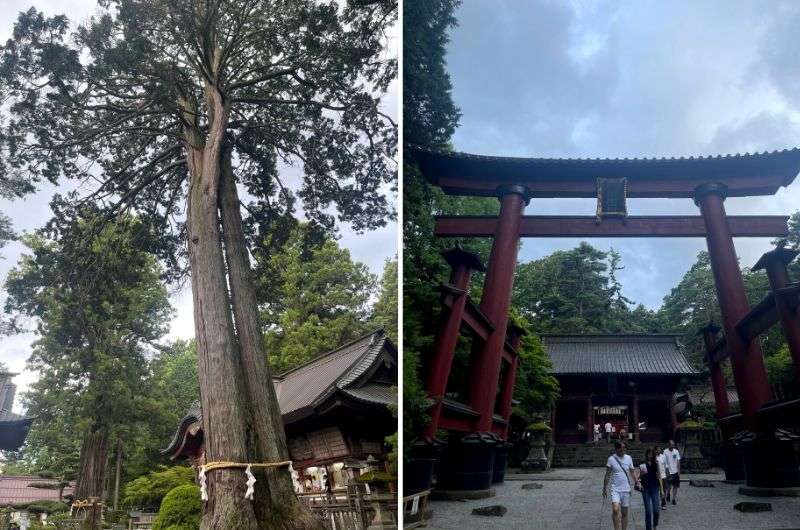
The sacred 1000-year-old cypress on the left and the tallest wooden torii of Japan on the right
The main shrine building is a majestic sight (once again cooler from the outside than from the inside) and nearby stands the sacred Fuji Tarô Sugi, a 1000-year-old cypress, identifiable by the braided rope around its trunk. It’s one of the original trees that is said to protect the shrine.
The traditional starting point for Mount Fuji hike is right behind Kitaguchi Hongu Fuji Sengen Shrine's main hall. Old-school hikers often begin their journey with a prayer at the shrine and then proceed through the wooden torii gate at the shrine's rear. Nowadays, most people opt to start from the Fuji Subaru Line 5th Station, located halfway up the mountain, cutting the journey by over five hours.
- Allow 1 hour for your visit
- Tickets: free
Further reading: Fuji Hakone itinerary (there’s a lot more to do than just see Fuji!)
13. Futarasan shrine (Nikko, north of Tokyo)
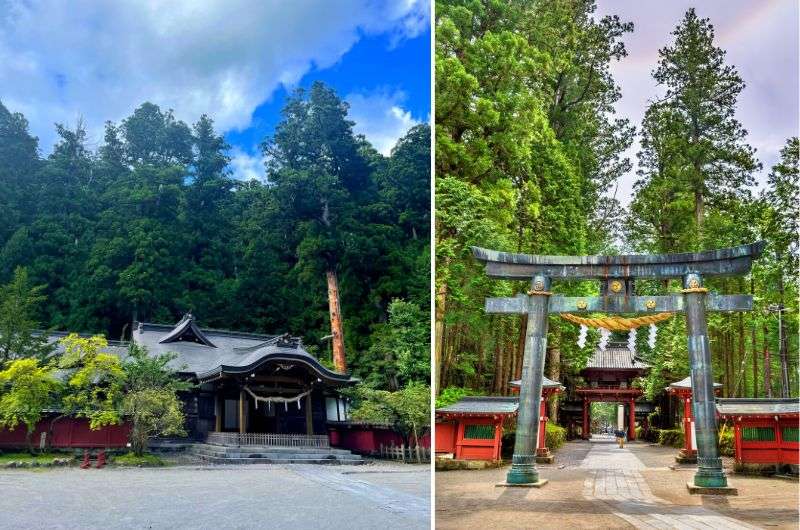
Futarasan shrine—historical and natural gem
If you're looking for a place that's equal parts ancient Japanese spirituality and Mother Nature's art gallery, then here you go, because Futarasan shrine is a double whammy of both. It’s pretty and mystical and grounding and I didn’t know I had it in me to feel such things.
Nestled in Nikko, a place so scenic it makes your average desktop wallpaper look bland, Futarasan Shrine is where you get to experience the Japanese knack for blending nature with history.
Hotel tip: Fairfield by Marriott Tochigi Nikko (if you forgive them the horrible coffee, this hotel was one of my absolute favorites)
The first thing I noticed, besides the stunning natural scenery, which we all know I love, is the sheer number of old shrine buildings. The second thing was the little cartoonish-looking statues all over the place. Very cutesy; apparently, they’re deities, and you can throw a few coins into the offering boxes located next to each one.
About 1 km (0.6 mi) south of Futarasan Shrine is a pretty, red bridge called Shinkyo Bridge. It’s still part of the complex—I told you it’s large! Trust me, it's the kind of bridge that makes you want to ponder life's mysteries... or just take more photos.
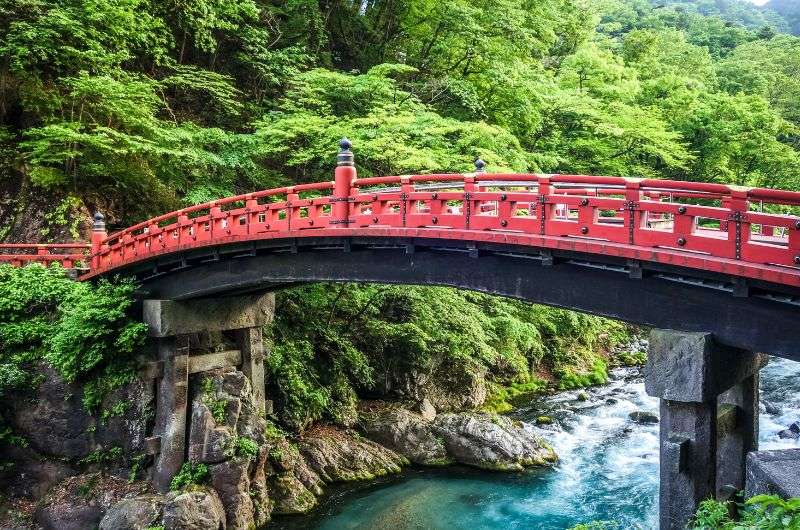
The Shinkyo Bridge
You can also further boost your experience by investing a whopping JPY 200 (USD 1.40) to enter the small garden area to the left of the offering hall. It‘s unbelievable, given your surroundings are already oozing zen, but just step inside and you’ll see you can still take it up a notch. It's a small, forested garden with more shrine halls, a spring, and old sacred trees that make you feel like you're in a Miyazaki movie. You can also get a better view of the main hall from there.
In short, Futarasan Shrine is not just a shrine; it’s an experience. You’ll forget all about any interiors you manage to spot, but everything that’s going on outside will more than make up for it. Just remember to bring some change for the deities, watch out for the mystical trees that are supposed to bring you love, and walk out to Shinkyo Bridge. Or don’t, I’m not your mom.
- Allow 2 hours for your visit
- Tickets: free except for the garden that costs JPY 200
14. Chureito Pagoda (Mt. Fuji)
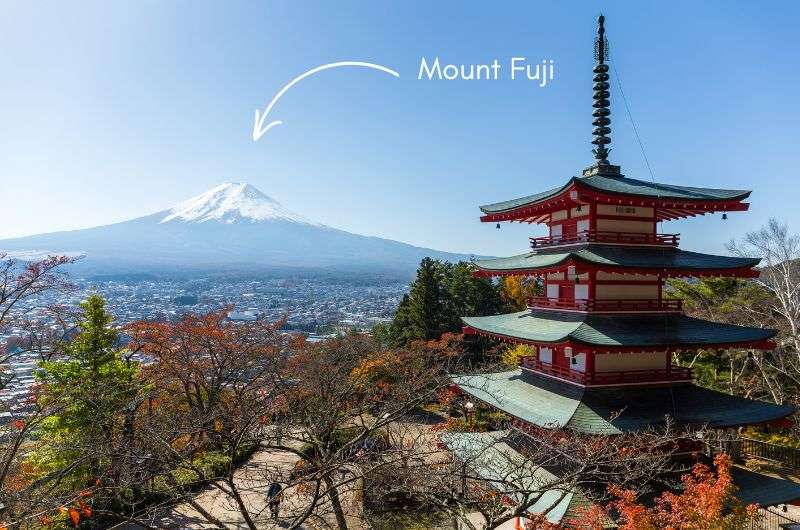
What you hope to see at Chureito Pagoda...
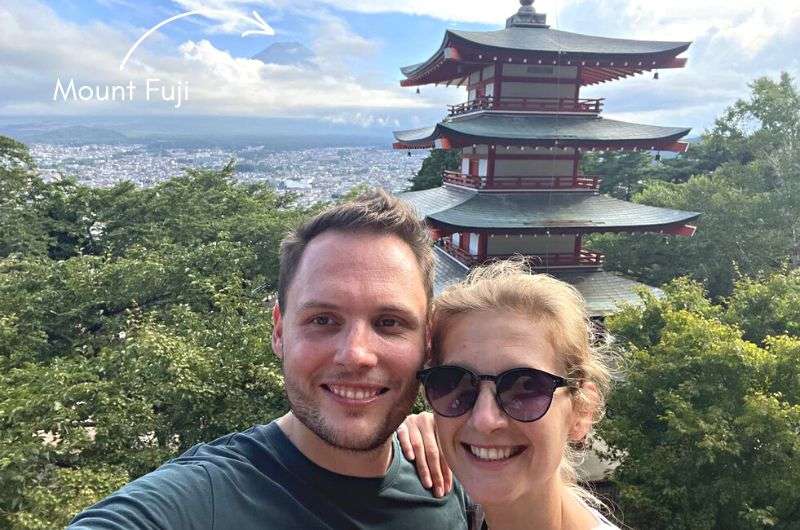
...and what we got... hey, it counts!
We visited Chureito Pagoda smack in the middle of summer, so we got none of the cherry blossoms of spring or the colors of fall, instead trying not to melt in the sweltering heat, push past the crowds, all the while trying to snap a good selfie AND hold our smiles long enough to get at least the very tip of Fuji into the frame when the clouds slowing floated along. Phew!
You need to go up about 400 stairs to get to Chureito Pagoda, so you’re basically guaranteed a nice sweaty shine on your forehead. It’s also too bad you don’t get the pagoda and Mt. Fuji over one of the 5 lakes—the city just isn’t as cool in the background. On the other hand, I somehow expected Fuji to be smaller than it is, but in reality, it’s a monster!
Why is this place at the end of my list of top temples in Japan? Well, Mt. Fuji is what makes this viewpoint a must-visit. Not the pagoda. I’d come here even if there was no pagoda, but would I come here if there was no Mt. Fuji? Probably not.
It’s a quick stop once you huff and puff up the stairs. Take your photos and head back down again. The parking lot is right under the stairs.
- Allow 30 minutes for your visit
- Tickets: free
15. Horyu-ji (Nara)
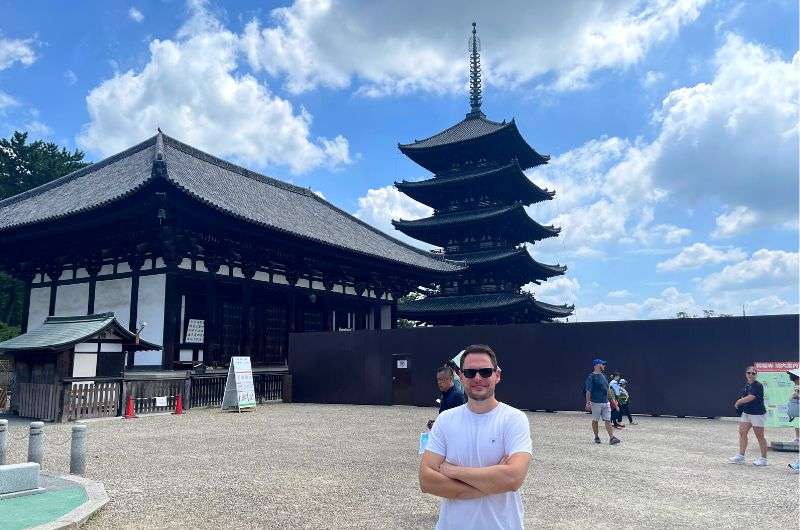
Horyu-ji—birthplace of Buddhism
Finally, a place where you can contemplate just how much you loved all of Japan’s most beautiful temples and shrines, because—unless you run into way too many school groups—Horyu-ji is a little bit harder to reach from the center of Nara and therefore is blissfully tourist-less.
Horyu-ji's not just another temple on your Japan checklist; it's a journey back to the origins of Japanese culture and the birthplace of Buddhism in Japan. Plus, it houses the world's oldest wooden structure (it’s 2000 years old), so yeah, it's kind of a big deal.
First off, the peace and quiet here is surreal, especially compared to the more crowded spots in Nara and Kyoto. For me, that’s a huge plus, because I’m not exactly known as a people-love. It's like the crowds haven't caught on yet, which is fine by me.
You're literally walking in the footsteps of Prince Shotoku, the guy who not only brought Buddhism from China but also whipped up Japan's first constitution. Talk about multitasking! I’m impressed!
Pro tip: Give the temple a call and ask for a free guide. These folks are volunteers who are super passionate about Japan's history and culture, and I’ve heard they’re really good. We decided to wing it and explore on our own, so I don’t have firsthand experience, but it’s something that could be a good opportunityfor those who are interested. I was just so happy to get away from everyone to ruin the peace by asking a stranger to never leave my side and talk my ear off.
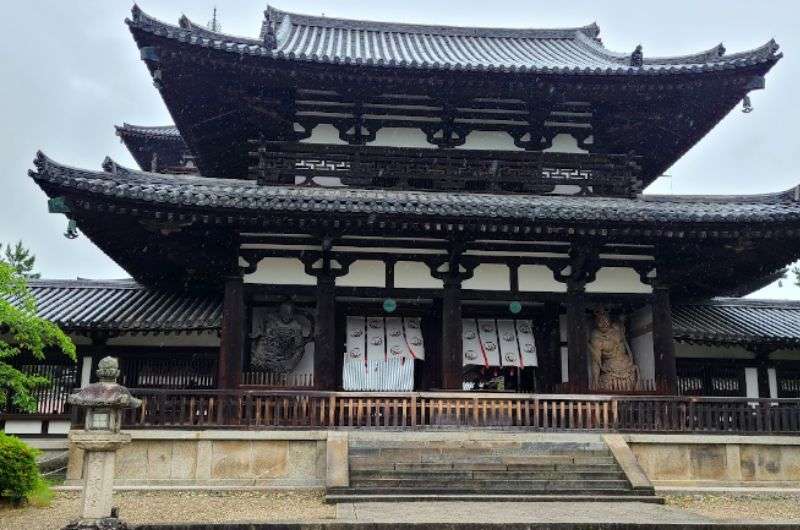
Horyu-ji temple is so underrated!
The museum collection at Horyu-ji is mind-blowing—we're talking about artifacts and statues dating back to the 6th century. It's like a crash course in Japanese art history, and I like me some history! But, fair warning, the place seems to be a magnet for school groups. It was a bit much, and I think they should probably figure out a way to regulate the school trip tsunami.
In all, Horyu-ji might not be on every Nara itinerary, but it should be. It's an underrated gem that gives you a real sense of Japan's ancient history without the elbow-to-elbow crowds. Just remember, you're standing in a place where Japan's cultural and spiritual journey took a giant leap forward. No biggie, right?
This post contains affiliate links. I earn a small commission if you make bookings through my links, at no additional cost to you. Thank you for your support!


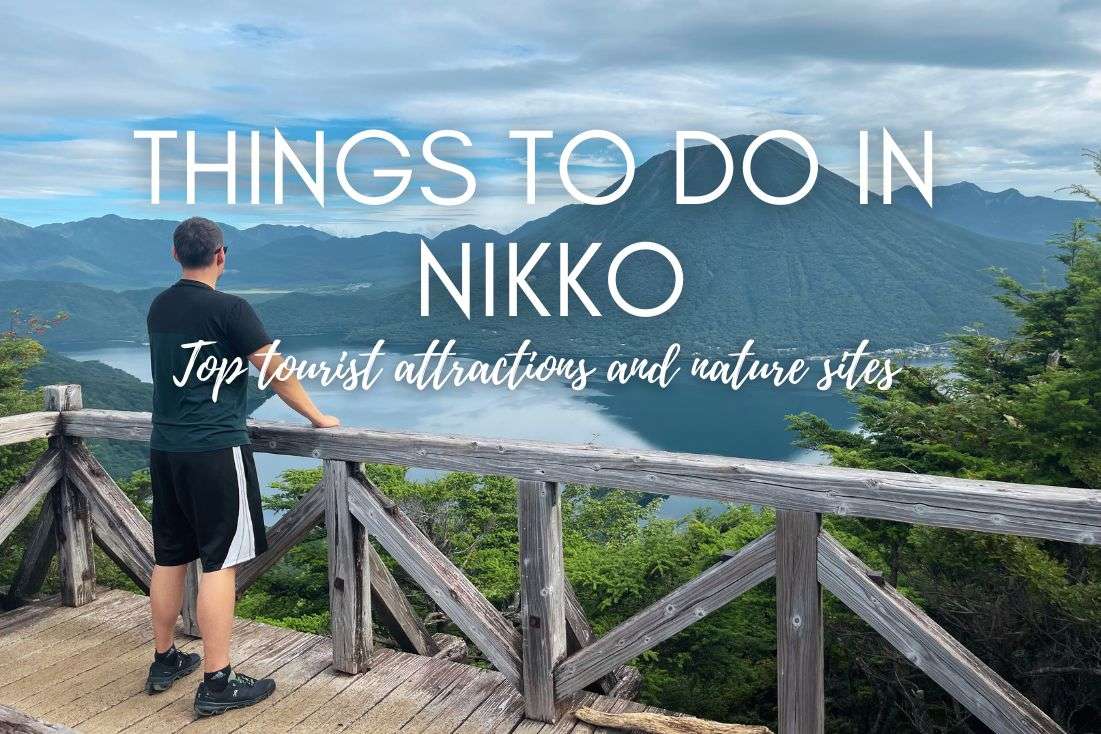
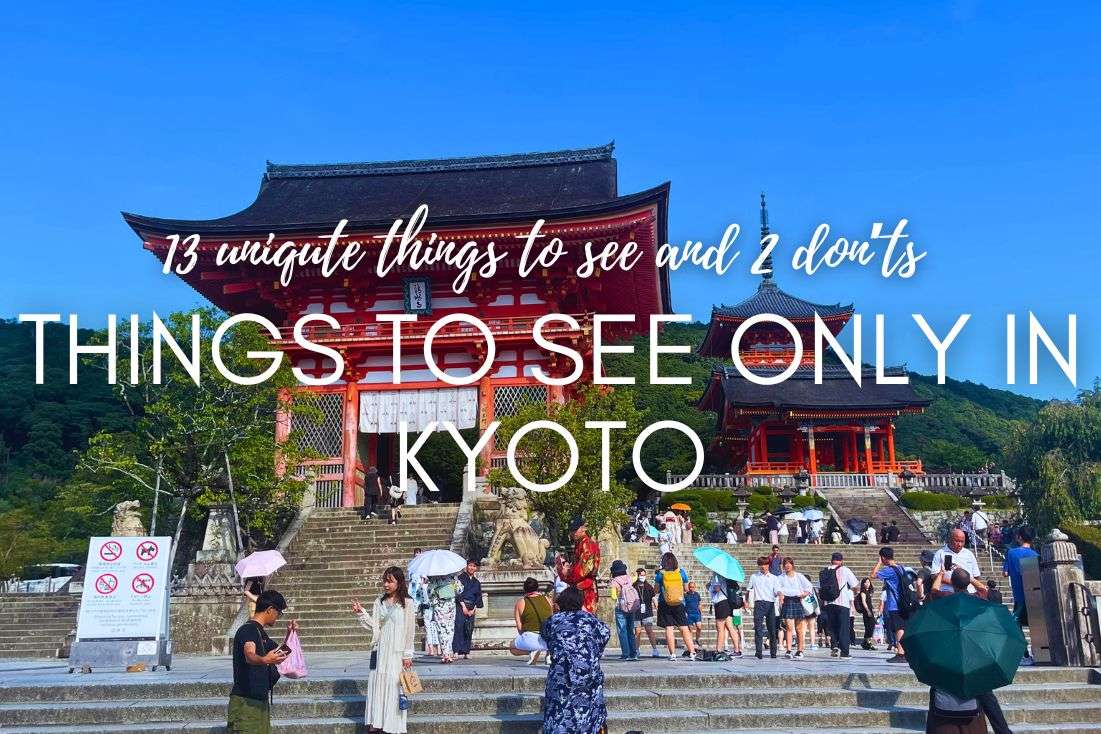
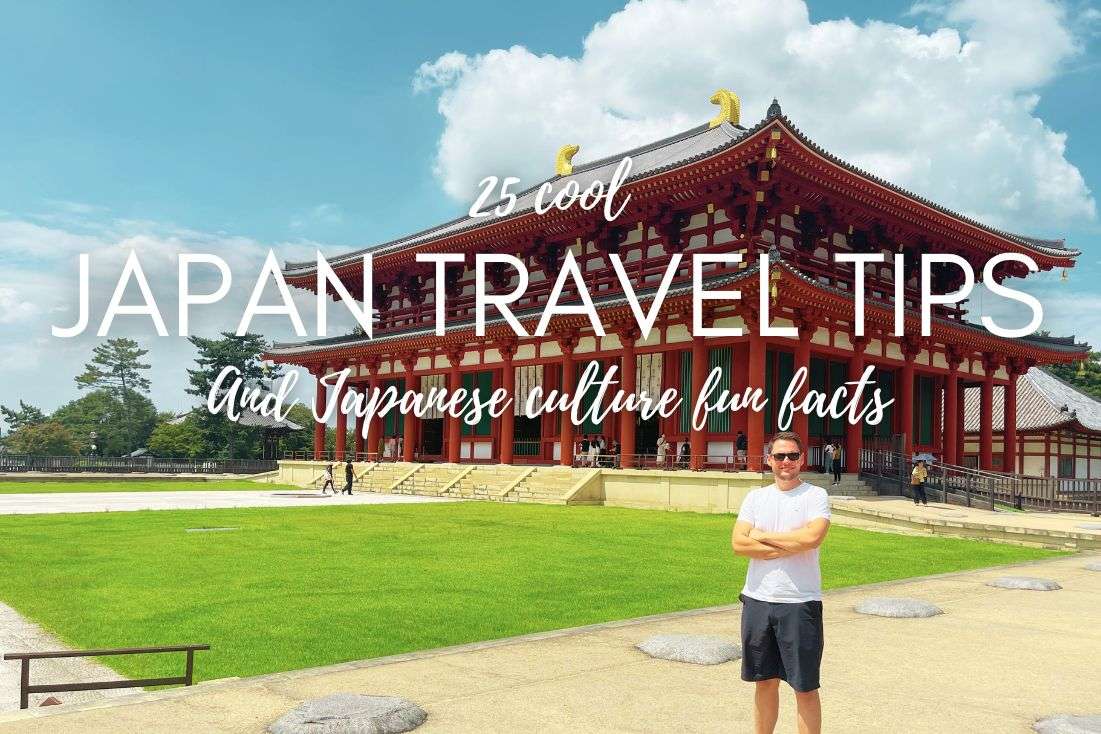





Comments | Thoughts? Give us a shout!